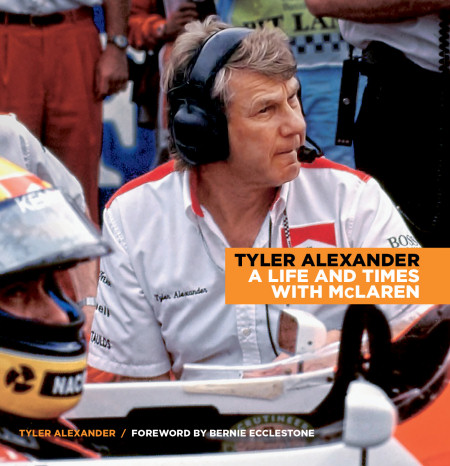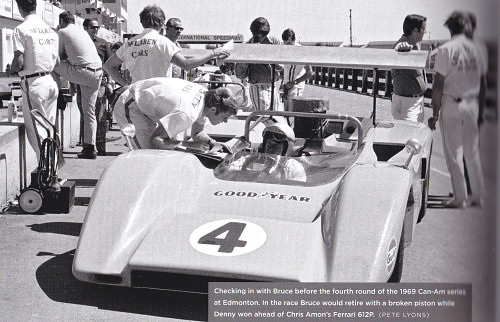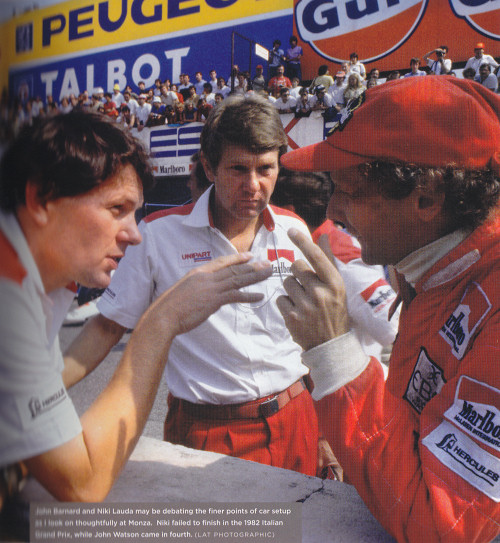The Way It Is/ A life and times with McLarenby Gordon Kirby |
 Tyler Alexander is a rare bird. He's by far the most experienced and accomplished American ever to compete in Formula 1 and over more than forty years from 1963-2008 cars prepared or seriously influenced by Alexander won more than 190 major races in Formula 1, Can-Am, USAC, CART, international sports car racing and the old Tasman Series. Included in his remarkable record are five consecutive Can-Am championships from 1967-'71, two Indy 500 wins in 1974 and '76, and eight Formula 1 world championships between 1974-'08, all with McLaren.
Tyler Alexander is a rare bird. He's by far the most experienced and accomplished American ever to compete in Formula 1 and over more than forty years from 1963-2008 cars prepared or seriously influenced by Alexander won more than 190 major races in Formula 1, Can-Am, USAC, CART, international sports car racing and the old Tasman Series. Included in his remarkable record are five consecutive Can-Am championships from 1967-'71, two Indy 500 wins in 1974 and '76, and eight Formula 1 world championships between 1974-'08, all with McLaren.
At long last Tyler's book 'A life and times with McLaren' has been published by David Bull. It's a typical, high quality Bull book, well designed with a full range of photos filling more than 400 pages and is highly recommended reading. Back in 1963, Tyler was a founding member of Bruce McLaren Motor Racing and was a key man in the original, unlimited Can-Am's 'Bruce and Denny Show'. After McLaren was killed while testing a Can-Am car in 1970, Tyler's longtime friend and partner Teddy Mayer took over ownership of the team. Mayer and Alexander ran the McLaren team for the next ten years, racing successfully in Can-Am, Formula 1, and USAC and CART Indy cars until selling out to Ron Dennis in 1980. Mayer continued as Dennis's junior partner for a year and half before Alexander and he deserted the F1 scene in 1982.  © David Bull But he wanted to return to F1 and Ron Dennis knew Tyler was essential to getting the best from his team. After taking a six-month sabbatical, Alexander rejoined McLaren in 1989 as a key man in running Dennis's very successful team through his retirement at the end of 2008. Alexander was born in Boston and raised in Hingham, Massachusetts, on Boston's south shore. The Alexander family spent Tyler's early years in Mars Hill, Maine and after moving back to Hingham for his high school years he went to Wentworth Engineering School, an aircraft engineering college in Boston. While he was there he met John Ffield, an MIT engineering student who raced a Cooper-Norton Formula 3 car. With Tyler's help, Ffield won the SCCA's northeastern Formula 3 championship. "That was how I met Timmy and Teddy Mayer, Roger Penske, Hap Sharp, Jim Hall, Mark Donohue--all those guys," Tyler recalls. "One time Teddy asked me and John Ffield to take their Formula Junior car to the Nassau Speedweeks for Penske to drive and we did. Roger finished second or third." For a while Alexander worked on Timmy Mayer's sports and formula cars. Mayer and his older brother Teddy were partners with Peter Revson in Rev-Em Racing. After an impressive start to his career in America young Mayer was hired by Bruce McLaren to be his teammate in a new venture called Bruce McLaren Motor Racing. Alexander first went to Europe in 1963 as one of John Mecom's mechanics working on Penske's Cooper F1-based Zerex Special sports/racer for the Guards Trophy race at Brands Hatch. Penske won aboard his controversial central-seat car, beating a pair of conventional Cooper Monaco sport/racers driven by Roy Salvadori and Timmy Mayer. "Teddy and Timmy went to Europe and I stayed in the States and worked with Roger Penske and John Mecom," Tyler recalls. While Tyler was in England with Penske and Mecom, Teddy Mayer asked him to help the fledgling McLaren team build a pair of Coopers for the 1964 Tasman series. "We had a little Sunday lunch at Teddy's house in Thames Ditton and that was the first time I met Bruce and Wally Wilmott who was his mechanic," Tyler remarks. "That was actually the start of Bruce McLaren Motor Racing, building those Coopers to go do the Tasman Series. And Timmy was killed in the last of those races. He hit a tree."  © Pete Lyons Tyler wound up transporting the Zerex/Cooper from Penske's last race with the car at Pensacola, Florida to New York, where he put it on a plane to London, then flew to England himself to spend two days getting the car ready for McLaren to race at Oulton Park. Alexander continued working for McLaren in the UK, converting the four-cylinder Climax-engined Zerex/Cooper into the first McLaren Group 7 car powered by an Oldsmobile V8. McLaren continued to race F1 Coopers in 1964 and '65 but at the end of 1965 he left Cooper to race his own F1 cars in 1966. That was also the first year of the unlimited Can-Am series in which the McLaren team would soon become the defining element. Looking back on those halcyon but deadly days in which racing drivers where killed on a regular basis, Alexander emphasizes the point that the biggest change in the sport over the years has been in safety. "Other than it being a much more commercial sport with much more money involved and worldwide television coverage," he observes, "two major things have changed enormously in the past thirty or forty years--the safety of the cars and improvements in the medical care and accident response. "The cars are still basically the same. They've got four wheels, the engine's sitting in the back, and so on, but the materials that the cars are made out of are much, much different than they were. Some of that has come about because of the materials that are used that weren't available back then. It's been a combination of developments in material technology and how to use them." Alexander says John Barnard's ground-breaking carbon chassis McLaren MP4/1 F1 car from 1981 was a major contribution to improving the crash-ability of racing cars. "John Barnard doing the first proper carbon chassis was probably one of his major contributions to the sport," Tyler remarks. "He did a lot of things, but maybe more than anything he was the guy who pushed carbon chassis into the frontline of motor racing. With the chassis itself made out of carbon it's much more rigid and there are much more rigid rules in place where in the past there were no rules pertaining to how safe the car should be." He also credits Jackie Stewart for triggering a revolution in thinking about safety. "I think a lot of credit goes to Jackie Stewart for pushing for safety in the late sixties. Despite the fact that he made himself reasonably unpopular at the time he certainly deserves a lot of credit. Nor did he ever give up pushing for the safety issue. Being a driver he was just looking after himself. I think that was part of the problem. Most people thought he was only looking after himself but he was actually doing it for everybody else as well as himself. "The whole safety thing was appalling and eventually along came Jackie Stewart. Because of who he was and he was winning races and championships he had the clout to actually force something to happen whether people liked it or not. The safety improvements have saved a lot of lives."  © LAT "I've had a lot of friends who were killed and it's not a question of getting used to it," Alexander reflects. "But it happens. So what do you do? You can't do anything about it after it's happened. People die of all kinds of things, but some people who were friends of mine died in auto racing. Do you get hardened to it? Well, you probably do. It hurts, and you try to deal with it and everybody deals with it differently. "I remember being in a church with Leon Mandel at Peter Revson's funeral. And he asked me, 'How you doing?' I said, 'About eight out of ten.' He wasn't miffed, but he was very taken back. It was a very flip comment, but that's the way I dealt with it. "Later on, he wrote something about it, and said he thought it was a pretty flip comment at the time and he didn't expect that from me. But then he said he kind of realized what I was talking about and he understood that this was a way of dealing with it. You just grit your teeth and get on with it." Twenty years later Ayrton Senna's death at Imola seriously shocked the contemporary racing world in which the prospect of drivers dying had been all but forgotten. "Senna's death was horrendous because the guy was a good friend of mine," Tyler observes. "I had worked on his car quite a bit and I really liked the guy. And yes, you cried. But you gritted your teeth and got on with it. It's tough to deal with it. I think that, probably today, it's much harder for people to deal with because it happens much less often. I don't mean that in a callous way because you don't want it to happen, but in motor racing today, you don't think about it as a possibility as much as you used to. "But really, if you go motor racing you don't think about it, otherwise you wouldn't be here. Like we've always said, 'Motor racing is dangerous.' It says so on the back of the ticket. But if you drive one of these things, you get in it and you drive it. The fact that you can get hurt driving the car is something you put away somewhere because if you did think about it, you wouldn't do it." Tyler tells the whole story of his remarkable life in his book. It's one of those volumes that's sure to make its mark as essential reading for any true enthusiast of the sport. Again, I cannot recommend it enough. The book is now available from www.bullpublishing.com for $55.00 plus postage and handling. |
|
Auto Racing ~ Gordon Kirby
Copyright ~ All Rights Reserved |
